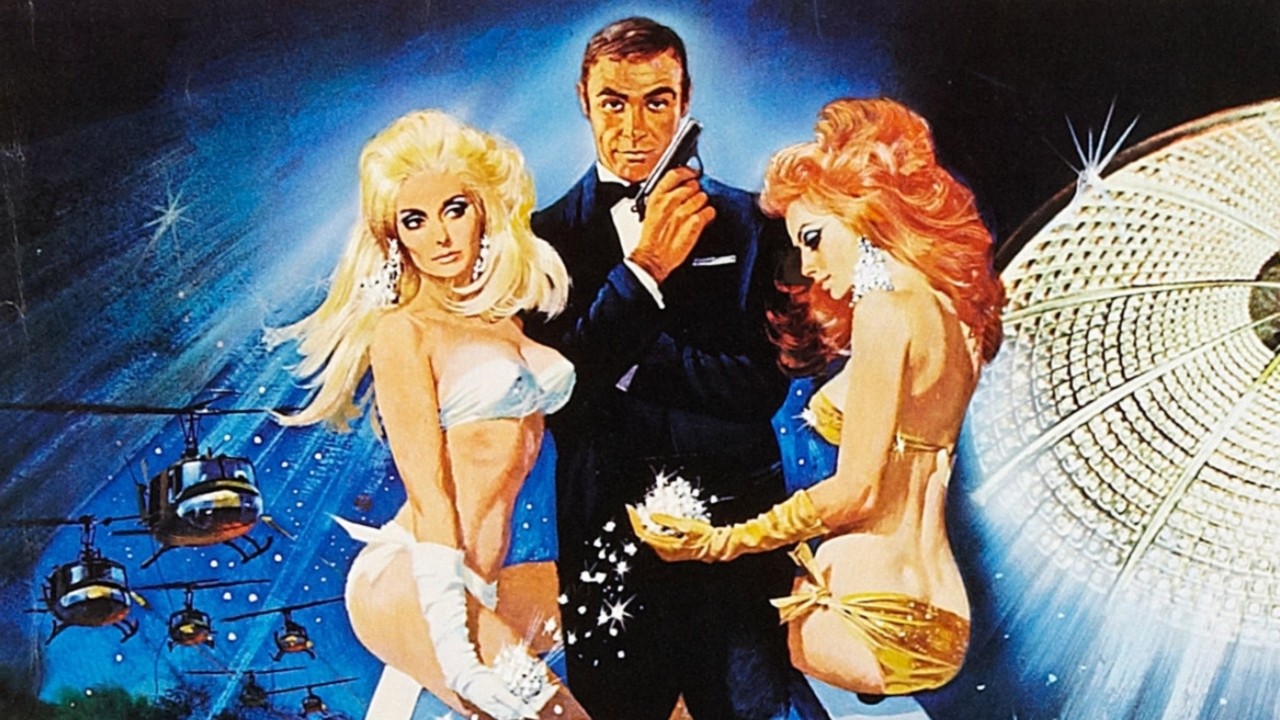Diamonds Are Forever (1971, Dir. Guy Hamilton):
She paused and smiled up at him. ‘Now it’s your turn again,’ she said. ‘Buy me another drink and tell me what sort of woman you think would add to you.’
Bond gave his order to the steward. He lit a cigarette and turned back to her. ‘Somebody who can make Sauce Bearnaise as well as love,’ he said.
‘Holy mackerel! Just any old dumb hag who can cook and lie on her back?’
‘Oh, no. She’s got to have all the usual things that all women have.’ Bond examined her. ‘Gold hair. Grey eyes. A sinful mouth. Perfect figure. And of course she’s got to make lots of funny jokes and know how to dress and play cards and so forth. The usual things.’
‘And you’d marry this person if you found her?’
‘Not necessarily,’ said Bond. ‘Matter of fact I’m almost married already. To a man. Name begins with M.’
— Ian Fleming, Diamonds Are Forever
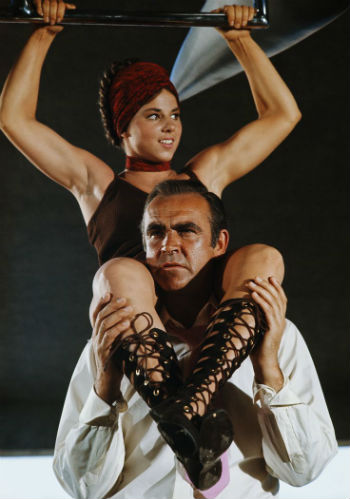 To enjoy Diamonds Are Forever, it’s best to banish the preceding James Bond film, On Her Majesty’s Secret Service, from your memory. After all, that’s what the Bond production team did. Disappointed by Majesty’s grosses, producers Albert Broccoli and Harry Saltzman looked at Diamonds as an opportunity to return Bond to what they perceived audiences liked. Majesty’s took Bond as a character right to the precipice; Diamonds would make a 180-degree spin towards gaudy, light, consequence-free entertainment. Fleming’s novel is a slight adventure in which Bond mixes it up with the Mob, and is primarily memorable for his wry observations on American culture, and for Bond gal Tiffany Case, a tough-talking broad who flummoxes 007 with her neurotic behavior (’cause she’s an American, after all). As a skeleton upon which the producers could graft any narrative of their choosing, the book was a perfect candidate.
To enjoy Diamonds Are Forever, it’s best to banish the preceding James Bond film, On Her Majesty’s Secret Service, from your memory. After all, that’s what the Bond production team did. Disappointed by Majesty’s grosses, producers Albert Broccoli and Harry Saltzman looked at Diamonds as an opportunity to return Bond to what they perceived audiences liked. Majesty’s took Bond as a character right to the precipice; Diamonds would make a 180-degree spin towards gaudy, light, consequence-free entertainment. Fleming’s novel is a slight adventure in which Bond mixes it up with the Mob, and is primarily memorable for his wry observations on American culture, and for Bond gal Tiffany Case, a tough-talking broad who flummoxes 007 with her neurotic behavior (’cause she’s an American, after all). As a skeleton upon which the producers could graft any narrative of their choosing, the book was a perfect candidate.
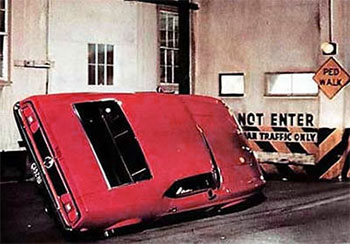 To regain box office gold, the logical choice was to hire the man behind Goldfinger, and so director Guy Hamilton was brought back into the fold. Early script treatments even had Goldfinger’s twin brother as the heavy (with the throwaway line “Ah, old Auric… Mother always thought he was a bit retarded”), before the writers settled on Ernst Stavro Blofeld once again as the primary villain. On Her Majesty’s Service ended on an unresolved note, with Bond’s bride dead and Bond seemingly primed for revenge against Blofeld, but none of that context carries over. No, this was to be a romp above all else.
To regain box office gold, the logical choice was to hire the man behind Goldfinger, and so director Guy Hamilton was brought back into the fold. Early script treatments even had Goldfinger’s twin brother as the heavy (with the throwaway line “Ah, old Auric… Mother always thought he was a bit retarded”), before the writers settled on Ernst Stavro Blofeld once again as the primary villain. On Her Majesty’s Service ended on an unresolved note, with Bond’s bride dead and Bond seemingly primed for revenge against Blofeld, but none of that context carries over. No, this was to be a romp above all else.
For a time American actor John Gavin (best known as Janet Leigh’s stiff-ass boyfriend in Psycho) was pegged to be the new Bond, but United Artists President David Picker, sensing imminent disaster, insisted that Broccoli and Saltzman make a pitch to Sean Connery that he couldn’t refuse. Connery would return for one picture, and as recompense he would receive $1 million in salary (an unheard-of figure at the time) as well as the green light on two productions of his own (only one of which was made, The Offense). As a consequence of Connery’s payout, the producers pinched pennies on the budget this time around. Las Vegas and Los Angeles instead of exotic locales. Bond would turn in his Aston Martin for a production-line Mustang. No one was silly enough to believe that all this would return Bond to the glories of Goldfinger, but with Hamilton and Connery back on board, the producers had to be pretty confident that the audiences would return, at least.
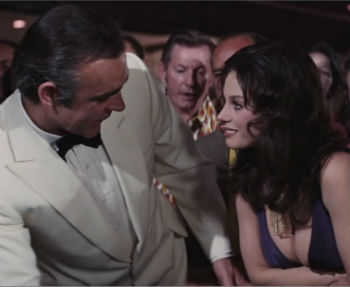 Financially speaking, the producers were correct. Diamonds Are Forever doubled Majesty’s grosses stateside, even though it fell short of Thunderball and Goldfinger numbers. But the days of Bond as a cultural phenomenon were now over. Rather than setting trends, he had become the emblem of an aging genre that was getting squeezed by the explosion of ’70s indie cinema on one side, and the fast-approaching blockbusters of Spielberg and Lucas on the other. Diamonds finds Bond in full retreat to the good old days, to a time when a playboy agent thwarting world annihilation was considered cool. As usual, Blofeld is holding the world to ransom (a laser satellite powered by diamonds this time), and as usual, Bond hits the gaming tables, ogles a few ladies, endures a few close shaves, and leads a final assault on the villain’s lair as the doomsday clock ticks down.
Financially speaking, the producers were correct. Diamonds Are Forever doubled Majesty’s grosses stateside, even though it fell short of Thunderball and Goldfinger numbers. But the days of Bond as a cultural phenomenon were now over. Rather than setting trends, he had become the emblem of an aging genre that was getting squeezed by the explosion of ’70s indie cinema on one side, and the fast-approaching blockbusters of Spielberg and Lucas on the other. Diamonds finds Bond in full retreat to the good old days, to a time when a playboy agent thwarting world annihilation was considered cool. As usual, Blofeld is holding the world to ransom (a laser satellite powered by diamonds this time), and as usual, Bond hits the gaming tables, ogles a few ladies, endures a few close shaves, and leads a final assault on the villain’s lair as the doomsday clock ticks down.
Based on those story points, the Bond crew could fashion the movie in their sleep, and indeed, they sleepwalk through this one. The production has a distinctly sloppy quality; the special effects are second-rate, character motivations are half-baked, continuity goes by the wayside, and save for a nifty car chase through downtown Vegas with that Mustang, the action scenes fizz instead of pop. Characters like Lana Wood’s very buxom, very bubbly Plenty O’Toole (“Named after your father perhaps”) show up, disappear from the narrative, and then turn up dead before we can figure out their significance. One wonders if an editing pro like Peter Hunt could have tamed these kinks out of the story, and given the proceedings more drive. Even Ken Adam’s opulent sets seem bedraggled this time around, as if the budget couldn’t spring for materials spiffier than fiberglass and plywood.
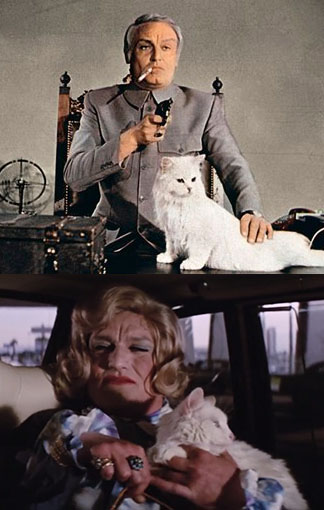 Diamonds Are Forever is a hangover of a movie all right, but what better place to have a hangover than ’70s Vegas, in its openly sleazy Hunter S. Thompson days? If nothing else, the film is a superb time capsule of a particular time period, where we can amuse ourselves with the garish (a sting operation takes place in a Circus Circus casino, elephants and slot machines abounding) as well as the plain disastrous (Bond in a broad pink tie). Broccoli and Saltzman, probably recognizing that the film’s pleasures were incidental to its quality, at least have the courage to get as weird as possible. Broccoli’s old buddy Howard Hughes gets a shout-out in the form of reclusive millionaire Willard Whyte, played by none other than “Sausage King” Jimmy Dean. No super-strong henchmen for Bond to face this time around: instead two cute female gymnasts named Bambi and Thumper, and two very fey gay hitmen named Wint (scene-stealing Bruce Glover) and Kidd (jazz musician Putter Smith, just the opposite). A major action sequence has Bond escaping the cops in a moon buggy across the Mojave desert, because, well, why not? The secondary characters are either dim gangsters, or dimmer police officers. Even Blofeld seems to know that this is all a lark. In previous films the head of SPECTRE was portrayed as a lunatic or a formidable mastermind; as played by Charles Grey here, he’s a very arch, very posh Englishman, as likely to quote Rouchefoucald as blackmail the free world. Surely no one in their right mind could have greenlighted the scene in which Grey dresses up in drag to elude capture, yet there it is, as bold as Technicolor. Clearly, being in one’s right mind has nothing to with this zonked-out film.
Diamonds Are Forever is a hangover of a movie all right, but what better place to have a hangover than ’70s Vegas, in its openly sleazy Hunter S. Thompson days? If nothing else, the film is a superb time capsule of a particular time period, where we can amuse ourselves with the garish (a sting operation takes place in a Circus Circus casino, elephants and slot machines abounding) as well as the plain disastrous (Bond in a broad pink tie). Broccoli and Saltzman, probably recognizing that the film’s pleasures were incidental to its quality, at least have the courage to get as weird as possible. Broccoli’s old buddy Howard Hughes gets a shout-out in the form of reclusive millionaire Willard Whyte, played by none other than “Sausage King” Jimmy Dean. No super-strong henchmen for Bond to face this time around: instead two cute female gymnasts named Bambi and Thumper, and two very fey gay hitmen named Wint (scene-stealing Bruce Glover) and Kidd (jazz musician Putter Smith, just the opposite). A major action sequence has Bond escaping the cops in a moon buggy across the Mojave desert, because, well, why not? The secondary characters are either dim gangsters, or dimmer police officers. Even Blofeld seems to know that this is all a lark. In previous films the head of SPECTRE was portrayed as a lunatic or a formidable mastermind; as played by Charles Grey here, he’s a very arch, very posh Englishman, as likely to quote Rouchefoucald as blackmail the free world. Surely no one in their right mind could have greenlighted the scene in which Grey dresses up in drag to elude capture, yet there it is, as bold as Technicolor. Clearly, being in one’s right mind has nothing to with this zonked-out film.
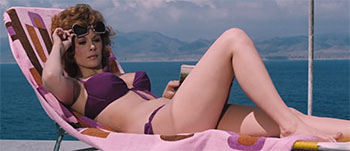 A few moments stand out amid the zaniness: Bond mountaineering his way up the side of a Vegas skyscraper with neon twinkling beneath him; a close-quarters fight in an elevator that seems to be teleported in from a different movie entirely; and Shirley Bassey’s amusingly smutty theme tune, which hints at a classiness the rest of the film lacks. You won’t find that classiness in Connery — overweight and saddled with a bad toupee (not to mention that horrid pink tie), he resembles one of those old rock stars well past his expiration date who still insists on going out on the road. And yet, he still manages to charm, his no-sweat, no-fuss performance the film’s sole source of dignity. It helps that he’s given his share of witty banter by screenwriter Tom Mankiewicz, who allows almost all the characters a chance to land a zinger or three. Speaking of zingers, Jill St. John is a zinger all by herself as Tiffany Case — sure she’s a bimbo, but at least she’s a bimbo who knows what she wants and has a way with a snide wisecrack.
A few moments stand out amid the zaniness: Bond mountaineering his way up the side of a Vegas skyscraper with neon twinkling beneath him; a close-quarters fight in an elevator that seems to be teleported in from a different movie entirely; and Shirley Bassey’s amusingly smutty theme tune, which hints at a classiness the rest of the film lacks. You won’t find that classiness in Connery — overweight and saddled with a bad toupee (not to mention that horrid pink tie), he resembles one of those old rock stars well past his expiration date who still insists on going out on the road. And yet, he still manages to charm, his no-sweat, no-fuss performance the film’s sole source of dignity. It helps that he’s given his share of witty banter by screenwriter Tom Mankiewicz, who allows almost all the characters a chance to land a zinger or three. Speaking of zingers, Jill St. John is a zinger all by herself as Tiffany Case — sure she’s a bimbo, but at least she’s a bimbo who knows what she wants and has a way with a snide wisecrack.
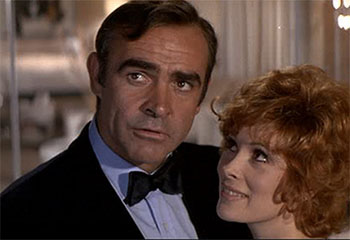 In the final analysis, Diamonds Are Forever is down-market and cut-rate, like a 2-carat diamond trying to pass itself off as a 5-carat stunner. Connery’s presence was enough to ensure the audience’s goodwill and box office success, but the film is a holding pattern, futzing around with the tried and true. As the movie concludes with Bond and Tiffany staring up at the night-time sky, Tiffany choosing at the last moment not to ask for Bond’s hand in marriage, everything reverting back to the way it always was, you can sense the filmmakers’ nostalgia and their understated fear about a Connery-less future (little did anyone know that Connery would resurface in the Bond universe over a decade later). The rest of the ’70s would find Bond making his way through that wilderness, and struggling for relevance in a world that was changing faster than he would care to admit.
In the final analysis, Diamonds Are Forever is down-market and cut-rate, like a 2-carat diamond trying to pass itself off as a 5-carat stunner. Connery’s presence was enough to ensure the audience’s goodwill and box office success, but the film is a holding pattern, futzing around with the tried and true. As the movie concludes with Bond and Tiffany staring up at the night-time sky, Tiffany choosing at the last moment not to ask for Bond’s hand in marriage, everything reverting back to the way it always was, you can sense the filmmakers’ nostalgia and their understated fear about a Connery-less future (little did anyone know that Connery would resurface in the Bond universe over a decade later). The rest of the ’70s would find Bond making his way through that wilderness, and struggling for relevance in a world that was changing faster than he would care to admit.

